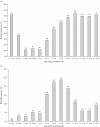Current epidemiological aspects of human parvovirus B19 infection during pregnancy and childhood in the western part of Germany
- PMID: 17064457
- PMCID: PMC2870617
- DOI: 10.1017/S095026880600731X
Current epidemiological aspects of human parvovirus B19 infection during pregnancy and childhood in the western part of Germany
Abstract
This investigation was undertaken to provide detailed information on the epidemiology of human parvovirus B19 (B19) infection during pregnancy and childhood in the western part of Germany. Between 1997 and 2004, 40,517 sera from pregnant women aged 17-45 years and 6060 sera from children and young adults were tested for B19 IgG and IgM in our laboratory. In pregnant women, both the history of a 'specific' (OR 7.7, 95% CI 5.2-11.4) and a 'non-specific' rash (OR 3.3, 95% CI 1.5-7.1) was predictive for B19 IgM positivity. The B19 IgG prevalence was 69.2% (4097/5924) in a subgroup of asymptomatic pregnant women screened for B19 antibodies. In children, the age-specific IgG-positivity rate increased from 12.2% (66/541) at 2 years of age to 71.9% (396/551) in those older than 10 years. In conclusion, the prevalence of B19 IgG in pregnant women from the western part of Germany is higher then previously reported. Contact with children aged 3-10 years is a major risk factor for exposure to B19. Pregnant women with the history of a 'non-specific' rash should also be evaluated for acute B19 infection.
Figures




Similar articles
-
The burden of parvovirus B19 infection in women of childbearing age in England and Wales.Epidemiol Infect. 2007 Nov;135(8):1354-62. doi: 10.1017/S0950268807007856. Epub 2007 Feb 12. Epidemiol Infect. 2007. PMID: 17291377 Free PMC article.
-
Maternal human parvovirus B19 infection and the risk of fetal death and low birthweight: a case-control study within 35 940 pregnant women.BJOG. 2009 Oct;116(11):1492-8. doi: 10.1111/j.1471-0528.2009.02211.x. BJOG. 2009. PMID: 19769750
-
Seroprevalence of parvovirus B19 IgG and IgM antibodies among pregnant women in Oyo State, Nigeria.J Infect Dev Ctries. 2013 Dec 15;7(12):946-50. doi: 10.3855/jidc.3157. J Infect Dev Ctries. 2013. PMID: 24334941
-
Seroprevalence and geographical distribution of parvovirus B19 antibodies in pregnant women: A-meta analysis.J Immunoassay Immunochem. 2023 Mar 4;44(2):103-116. doi: 10.1080/15321819.2023.2167520. Epub 2023 Jan 20. J Immunoassay Immunochem. 2023. PMID: 36661768 Review.
-
RELATIONSHIP BETWEEN PARVOVIRUS B19 AND OSTEOARTHRITIS: LITERATURE REVIEW.Acta Ortop Bras. 2023 Jul 17;31(3):e267046. doi: 10.1590/1413-785220233103e267046. eCollection 2023. Acta Ortop Bras. 2023. PMID: 37469492 Free PMC article. Review.
Cited by
-
The seroprevalence of parvovirus B19 infection in pregnant women in Sudan.Epidemiol Infect. 2015 Jan;143(2):242-8. doi: 10.1017/S0950268814000600. Epub 2014 Mar 20. Epidemiol Infect. 2015. PMID: 24650427 Free PMC article.
-
Comprehensive surveillance data suggest a prominent role of parvovirus B19 infection in Belarus and the presence of a third subtype within subgenotype 1a.Sci Rep. 2021 Jan 13;11(1):1225. doi: 10.1038/s41598-020-79587-2. Sci Rep. 2021. PMID: 33441645 Free PMC article.
-
Molecular-genetic characterization of human parvovirus B19 prevalent in Kerala State, India.Virol J. 2021 May 5;18(1):96. doi: 10.1186/s12985-021-01569-1. Virol J. 2021. PMID: 33952289 Free PMC article.
-
The magnitude and correlates of Parvovirus B19 infection among pregnant women attending antenatal clinics in Mwanza, Tanzania.BMC Pregnancy Childbirth. 2017 Jun 7;17(1):176. doi: 10.1186/s12884-017-1364-y. BMC Pregnancy Childbirth. 2017. PMID: 28592274 Free PMC article.
-
Genotypic Characterization of Human Parvovirus B19 Circulating in the 2024 Outbreak in Tuscany, Italy.Pathogens. 2025 Jan 28;14(2):121. doi: 10.3390/pathogens14020121. Pathogens. 2025. PMID: 40005498 Free PMC article.
References
-
- Anderson MJ et al. Human parvovirus, the cause of erythema infectiosum (fifth disease)? Lancet. 1983;1:1378. - PubMed
-
- Gillespie SM et al. Occupational risk of human parvovirus B19 infection for school and day-care personnel during an outbreak of erythema infectiosum. Journal of the American Medical Association. 1990;263:2061–2065. - PubMed
-
- Gratacós E et al. The incidence of human parvovirus B19 infection during pregnancy and its impact on perinatal outcome. Journal of Infectious Diseases. 1995;171:1360–1363. - PubMed
-
- Harger JH et al. Prospective evaluation of 618 pregnant women exposed to parvovirus B19: risks and symptoms. Obstetrics and Gynecology. 1998;91:413–420. - PubMed
-
- Maksheed M et al. The prevalence of antibody to human parvovirus B19 in pregnant women in Kuwait. Acta Tropica. 1999;73:225–229. - PubMed
Publication types
MeSH terms
Substances
LinkOut - more resources
Full Text Sources
Medical

